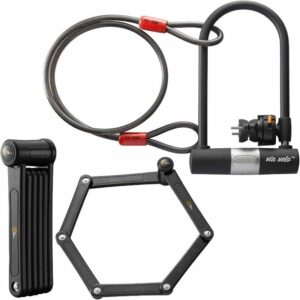Maximizing Your E-Bike Battery's Life: A Comprehensive Guide
Key Takeaways
-
Detailed Insights into Battery Types: Exploring the chemical composition, advantages, and limitations of Lithium-ion (Li-ion), Nickel-metal hydride (NiMH), and Lead Acid batteries, including discussions on energy density, lifecycle, and cost implications for users.
-
Advanced Charging Techniques: Guidelines on optimal charging strategies to enhance battery lifespan, such as avoiding deep discharges, understanding the significance of maintaining battery charge levels between 20% and 80%, and the effects of fast charging on battery health.
-
Battery Management Systems (BMS) Explained: Delving into how BMS protects batteries from overcharging, overheating, and deep discharge, thereby ensuring reliability and safety, and how it contributes to the overall longevity of the battery.
-
Influence of External Factors on Battery Performance: A comprehensive analysis of how rider weight, terrain, weather conditions, and riding style impact battery range and efficiency, offering practical tips for maximizing performance under various conditions.
-
Comprehensive Battery Maintenance and Care: Advanced maintenance tips beyond regular charging and storage recommendations, including periodic calibration, software updates for smart batteries, and professional inspection routines to prevent common issues and extend battery life.
Powering the Ride - The Heart of Your E-Bike
Electric bikes (e-bikes) have surged in popularity, offering an eco-friendly, efficient, and exhilarating way to navigate the urban sprawl and beyond. At the heart of every e-bike’s performance lies its battery, a pivotal component that dictates range, durability, and overall riding satisfaction. As e-bike enthusiasts embark on their two-wheeled adventures, questions about battery types, lifespan, and proper maintenance emerge as central themes in maximizing the joy and longevity of their rides. This introduction dives into the importance of e-bike batteries, exploring the various types available, and addressing common inquiries on how to sustain their life and efficiency. From leisurely jaunts through city streets to challenging off-road escapades, understanding your e-bike’s power source is key to unlocking its full potential and ensuring a seamless, enjoyable cycling experience.

Energizing the Journey: The Core of E-Bike Technology
This section delves into the diverse world of e-bike batteries, offering insights into the main types used in today’s electric bicycles. From the widely favored Lithium-ion batteries known for their lightweight and efficiency, to the durable and eco-friendly Nickel-metal hydride, the reliable Lead Acid, and the promising horizon of Emerging technologies like solid-state batteries, this part explains the technical aspects in a manner that’s accessible for beginners. Each battery type’s unique features, benefits, and potential limitations are covered to help riders make informed decisions about their e-bike investments.
Lithium-ion (Li-ion)
Li-ion batteries are the most common in modern e-bikes, prized for their lightweight, high energy density, and longevity. They offer more cycles (charges and discharges) compared to other types, making them a preferred choice for frequent riders. Their efficiency and compact size enable sleek e-bike designs without compromising on power or range.
Nickel-metal hydride (NiMH)
NiMH batteries are known for their durability and environmental friendliness, featuring a longer lifespan than lead-acid batteries. They can store more energy than lead-acid batteries, making them a good middle-ground option. However, they are heavier and more expensive than Li-ion batteries and can experience a “memory effect” that may reduce their effective lifespan if not properly managed.
Lead Acid
Lead-acid batteries are the oldest type of rechargeable battery and are notable for their high power output and low cost. They are heavier and have a lower energy density, which translates to shorter ranges and a heavier overall bike weight. Ideal for budget-conscious consumers or applications where weight and range are not critical.
Emerging Technologies
Innovations like solid-state batteries are on the horizon, promising even higher energy densities, improved safety, and longer lifespans. These batteries could revolutionize e-bike battery technology by offering lighter weights, extended ranges, and faster charging times, though they are not yet widely available in the market.
Understanding Battery Lifespan: Navigating Through Charge Cycles and Beyond
Charge Cycles and What They Mean
The lifespan of an e-bike battery is a critical aspect that influences the overall experience and cost-effectiveness of riding an e-bike. At its core, the lifespan is predominantly measured in charge cycles, which refer to the complete cycle of discharging and then fully charging a battery. A single cycle is counted when you’ve used (and then recharged) 100% of the battery’s capacity, but not necessarily all at once. For instance, using half of your battery’s capacity one day and then fully charging it back up, followed by another half the next day and recharging it again, counts as one complete cycle.
A typical Lithium-ion battery offers between 500 to 1,000 charge cycles before its capacity starts to degrade noticeably, meaning it won’t hold as much charge as when it was new. This means if you’re using your e-bike battery down to 50% every day and recharging it, you can expect several years of use before needing a replacement.
Factors Affecting Battery Lifespan
Temperature
 Extreme temperatures, both hot and cold, can significantly impact battery health. Keeping your battery within a moderate temperature range when charging and storing can help preserve its lifespan.
Extreme temperatures, both hot and cold, can significantly impact battery health. Keeping your battery within a moderate temperature range when charging and storing can help preserve its lifespan.
Storage
Long-term storage conditions are pivotal. A lithium-ion battery, for example, prefers to be stored at a 40-60% charge level if not used for an extended period. Storing a battery either fully charged or fully depleted can lead to a reduction in its overall lifespan.
Usage Patterns
Frequent short charges can help maintain battery health longer than letting it discharge completely before recharging. Avoiding deep discharges and instead maintaining a charge level between 20% and 80% can extend the number of usable cycles.
By understanding and optimizing for these factors, e-bike riders can significantly influence the longevity and performance of their batteries, ensuring a more sustainable and cost-effective riding experience.
Optimizing Charging Practices: Ensuring Longevity and Performance
To optimize charging practices for e-bike batteries, it’s crucial to follow best practices for charging and storage, understand the effects of partial versus full charges, and recognize the importance of a Battery Management System (BMS). Proper charging habits can extend battery life, such as avoiding leaving the battery fully charged or completely depleted for long periods. Partial charging, keeping the battery between 20-80%, can also benefit longevity. The BMS plays a vital role in protecting the battery by preventing overcharging, balancing cells, and managing temperature, all of which contribute to optimized battery health and performance.
Best Practices for Charging and Storing Batteries
To maximize your e-bike battery’s life, always follow the manufacturer’s charging guidelines. Generally, it’s advised to charge the battery at room temperature and avoid charging immediately after riding, allowing it to cool down first. For storage, keep the battery in a cool, dry place and maintain a charge level between 40-60% if not used for extended periods.
 The Impact of Partial vs. Full Charges
The Impact of Partial vs. Full Charges
Partial charges are beneficial for lithium-ion batteries. Charging your battery from 20% to 80%, rather than 0% to 100%, can extend its overall lifespan by reducing stress and slowing down the wear process.
Understanding the Role of a Battery Management System (BMS)
A BMS is crucial for protecting the battery from overcharging, deep discharge, and overheating. It ensures each cell within the battery pack charges and discharges evenly, maintaining the health and efficiency of the battery. Always ensure your e-bike’s BMS is functioning correctly to optimize battery life.
Incorporating these practices can significantly enhance the longevity and reliability of your e-bike’s battery, contributing to a more enjoyable and sustainable riding experience.
Energizing Care: Prolonging Your E-Bike Battery Life
Maintenance and Care play pivotal roles in maximizing the lifespan and performance of your e-bike battery. Proper routine checks and cleaning, along with thoughtful storage, can greatly extend the time between necessary replacements.
Routine Checks and Cleaning: Regularly inspect your battery for any signs of damage or wear. Keep the battery terminals clean and free from debris to ensure a good connection with your e-bike. A soft cloth can be used for wiping down the battery case.
Storage Tips for Long-term Battery Health: If you’re not using your e-bike for an extended period, store the battery in a cool, dry place, ideally at a 40-60% charge level. Extreme temperatures, both hot and cold, can degrade the battery’s health over time.
When to Consider Battery Replacement: Be aware of signs like significantly reduced range, longer charging times, or physical damage. These indicators suggest it might be time to consider a battery replacement to ensure your e-bike continues to perform at its best.
Adhering to these maintenance and care guidelines can help ensure that your e-bike battery remains a reliable source of power for your journeys, keeping you riding longer and more efficiently.
For specific cleaning, maintenance, and storage procedures, as well as details on your battery’s warranty, it’s essential to refer to the manufacturer’s battery manual. Each e-bike and battery may have unique requirements and guidelines to ensure optimal performance and longevity, tailored to the design and specifications of your particular model. Always consult your manufacturer’s documentation for the most accurate and relevant advice.
Navigating Battery Challenges: E-Bike Battery Troubleshooting
When it comes to maintaining the health and efficiency of your e-bike’s battery, recognizing symptoms of degradation and addressing common issues promptly can significantly extend its useful life. Here’s a closer look at how to troubleshoot common battery problems:
Symptoms of Battery Degradation
Decreased range, longer charging times, and the battery not holding a charge as it used to are clear indicators of battery wear. Physical signs, such as swelling or leakage, are immediate red flags necessitating a closer examination.
Diagnosing and Addressing Common Problems
Start with the basics:
Charger: Ensure that the charger and cable are functioning correctly. A faulty charger can lead to improper charging, which might mimic battery issues.
E-bike Not Turning On: Check the main switch, battery pack’s fuse and speed controller, and ensure the battery is charged and cables are properly connected.
-
E-bike Not Speeding Up: Clean the feedback magnets, check brake switches, and ensure the correct mode is selected.
-
Faulty Battery Connectors or Cells: Inspect for loose connections and use a multimeter to check cell voltage, replacing if necessary.
-
Overheating Batteries: Avoid overcharging, and let the battery cool down between uses to prevent overheating.
-
Battery Won’t Charge: Align battery prongs and check for loose connections, considering battery lifecycle.
-
Swollen Battery Packs: Indicates a serious issue; cease use immediately and seek professional help.
-
Battery Voltage Drops Suddenly: This could be a sign of faulty cells; consider replacing or balancing the cells.
Understanding these signs and initial troubleshooting steps can empower e-bike owners to take proactive measures in maintaining battery health, ensuring a longer lifespan and more reliable performance from their electric bikes.
For more complex issues, such as cells failing to hold a charge, consulting a professional or referring to your e-bike manufacturer’s guidance is advised.
Environmental Considerations of Electric Bike Batteries
The environmental footprint of electric bicycles (e-bikes) is a topic of growing importance as their popularity soars. Key considerations around their sustainability revolve around the recycling and disposal of old batteries and the broader environmental impact of battery production and disposal.
Recycling and Disposing of Old Batteries
Lithium-ion batteries, the most common type used in e-bikes, pose significant environmental concerns when disposed of improperly, as they can leak dangerous chemicals into the soil. Fortunately, recycling facilities are becoming more widespread, offering a safer alternative to landfill disposal. These facilities handle not only lithium-ion but also NiCad batteries, which are equally harmful if not disposed of correctly. Organizations like CALL2RECYCLE in the United States are dedicated to ensuring these batteries are recycled properly, highlighting the increasing value of recycled lithium for use in new products despite current cost dynamics favoring new lithium extraction.
 Environmental Impact of Battery Production and Disposal
Environmental Impact of Battery Production and Disposal
The production of e-bike batteries involves extracting and processing raw materials, such as lithium, which requires significant energy and has notable environmental impacts. However, when compared to the environmental toll of manufacturing conventional vehicles, e-bikes emerge as a more sustainable option. The use phase of an e-bike, characterized by zero tailpipe emissions, represents a stark contrast to the pollution associated with cars and motorcycles. Furthermore, the advancements in battery recycling techniques have lessened the environmental impact associated with the disposal of these batteries. The durability of e-bike components, coupled with improved recycling, extends the life of e-bikes and minimizes their overall environmental footprint.
Indirect Environmental Impacts
It’s crucial to acknowledge that the electricity used to charge e-bike batteries may come from fossil fuel-burning power plants, indirectly contributing to air pollution. However, the shift towards renewable energy sources can significantly reduce this impact, making e-bikes powered by green electricity far less environmentally damaging. Studies in regions with a higher proportion of renewable energy sources have demonstrated that e-bikes can have a lower environmental impact than even non-assist bicycles, considering their complete lifecycle.
E-bikes stand as a testament to the balance between technology and sustainability, offering a pathway to reduced air pollution and promoting a healthier lifestyle. The ongoing advancements in battery technology and the increasing reliance on renewable energy for electricity generation promise to further diminish the environmental impacts of e-bikes, making them an even greener choice for future transportation.
FAQs on How Long Electric Bike Batteries Last
Q: What types of batteries are used in electric bikes?
Q: How long does an electric bike battery last before needing replacement?
Q: What factors can affect an electric bike battery’s lifespan?
Q: How can I maximize my e-bike battery’s life?
Q: What is the importance of a Battery Management System (BMS) in e-bikes?
Q: How should I store my e-bike battery for long periods of inactivity?
Q: Can electric bike batteries be recycled?
A: Electric bikes typically utilize Lithium-ion, Nickel-metal hydride, or Lead Acid batteries.
A: Around 500 to 1,000 charge cycles.
A: Temperature, storage conditions, and usage patterns.
A: Avoid extreme temperatures, deep discharges, and fully charging to 100% every time.
A: A BMS protects the battery from overcharging and overheating.
A: In a cool, dry place, at a 40-60% charge level.
A: Yes, particularly Lithium-ion batteries at specialized facilities.
Powering Ahead: Ensuring the Vitality of Your E-Bike Battery
In conclusion, the journey toward maintaining and extending the life of e-bike batteries is paved with knowledge, care, and responsibility. By understanding the different types of batteries, such as Lithium-ion, Nickel-metal hydride, and Lead Acid, riders can make informed decisions about their e-bikes. Optimizing charging practices, including avoiding extreme temperatures, adhering to partial rather than full charging cycles, and leveraging the benefits of a Battery Management System (BMS), are pivotal in preserving battery health.
Routine maintenance checks, proper storage conditions, and timely battery replacements ensure not only the longevity of the battery but also the sustainability of the ride. Troubleshooting common battery issues proactively can prevent minor problems from escalating into major inconveniences, ensuring a smooth and reliable e-biking experience.
Environmental considerations further highlight the importance of adopting e-bikes as a greener alternative to traditional transportation methods. By recycling old batteries and supporting advancements in battery technology and renewable energy sources, e-bike users contribute to a more sustainable and eco-friendly future.
This comprehensive approach to e-bike battery care and management not only enhances the riding experience but also aligns with broader environmental goals, fostering a future where technology, sustainability, and health converge on the path to a cleaner, greener planet.







